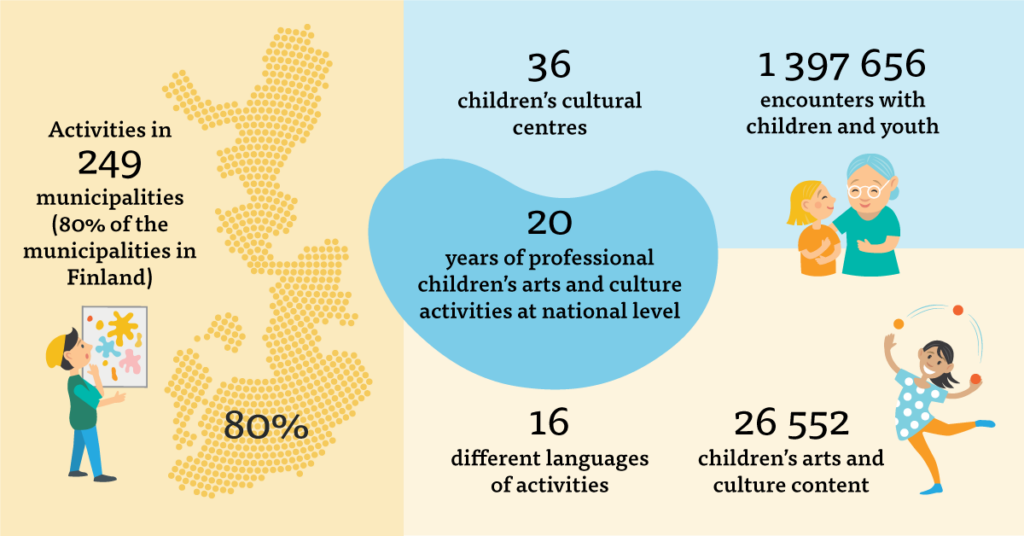The Association of Finnish Children’s Culture Centers is a nationwide network of professionally operating children’s arts and culture centres and organisations. Its members provide services locally and regionally throughout Finland. Its members have almost two million customer contacts every year, and their activities cover around 80% of Finland’s municipalities.
The 36 member centres of the Association of Finnish Children’s Cultural Centers produce annual statistics on their activities. With the statistical reform in 2022, high-quality and diverse statistical data will be collected on their activities. The purpose of the statistics is to provide comparable information on the activities of the Association and its members. The statistics serve not only the Association of Finnish Children’s Culture Centers and its members but also the funders of the activities, research, the media and Statistics Finland.
Statistical information on the activities of children’s cultural centres can be found in Statistics Finland’s publications since 2015, when the Association of Finnish Children’s Cultural Centers was founded.
A diverse membership provides a wide range of information
The members of the Association are national cultural operators, cultural services of municipalities and cities, networked centres formed by municipalities, and operators in the independent sector practitioners. To find out more about the membership, visit the Children’s Arts and Culture Network-page.
The members of the Association are very diverse – there are cultural services for children and young people in Finland’s largest cities, but also travelling children’s arts and cultural practitioners without a branch open to the public. They operate in both urban and remote areas, working with schools, early childhood education, childcare centres, reception centres, etc.
Statistics and figures for 2023
The statistics below are based on a statistical questionnaire for 2023 completed by 33 member centres. No statistics were received from three members. The statistics also exclude children’s arts and cultural practitioners who are not members of the Association of Finnish Children’s Cultural Centers.
Open activities for every child
Every child reached through arts activities is important. In 2023, the Association’s member centres encountered almost 1 400 000 children and young people. The activities of the Association’s members reached children in 294 municipalities across Finland.
The network of the Association of Finnish Children’s Cultural Centers provides services in several languages. In 2023, members organised content for children, young people and families with children in 16 different languages. In addition to the national languages, the languages included sign language, Ukrainian, Estonian, Dari, Igbo, Arabic and Chinese.

The target audience for the services provided by the children’s arts and cultural practitioners are children, families and professionals working with them. In 2023, the members of the Association of Finnish Children’s Cultural Centers organised workshops and clubs, open cultural centre activities, events, festivals, performances and exhibitions, and training courses. In total, 26 552 children’s arts and culture events, activities, exhibitions, events and events were organised.

In addition to the content organised in schools, cultural centres and other physical locations, the members produced a total of 887 online contents, such as videos, method guides or online exhibitions.


International, high-quality and sustainable activities
The Association of Finnish Children’s Culture Centers promotes international cooperation projects, cooperation and networking between the practitioners in the field. International projects often focus on the development of new operating models and expertise and the dissemination of best practices. Seventeen children’s cultural centres had international activities in 2023.
Fifteen centres had a sustainability certificate and/or a sustainability plan or guidelines in place. Seven had an Accessible Arts Hobby- Label.
21 member centres were implementing hobby activities based on the Finnish Model of Hobbies, and 31 were implementing the contents of cultural education plans.


